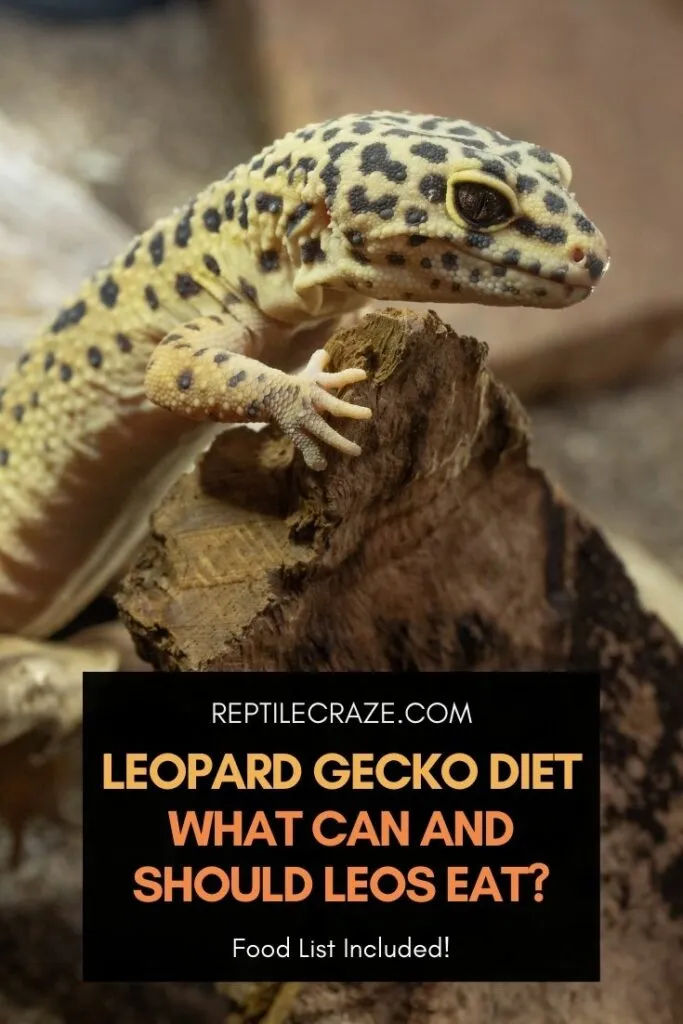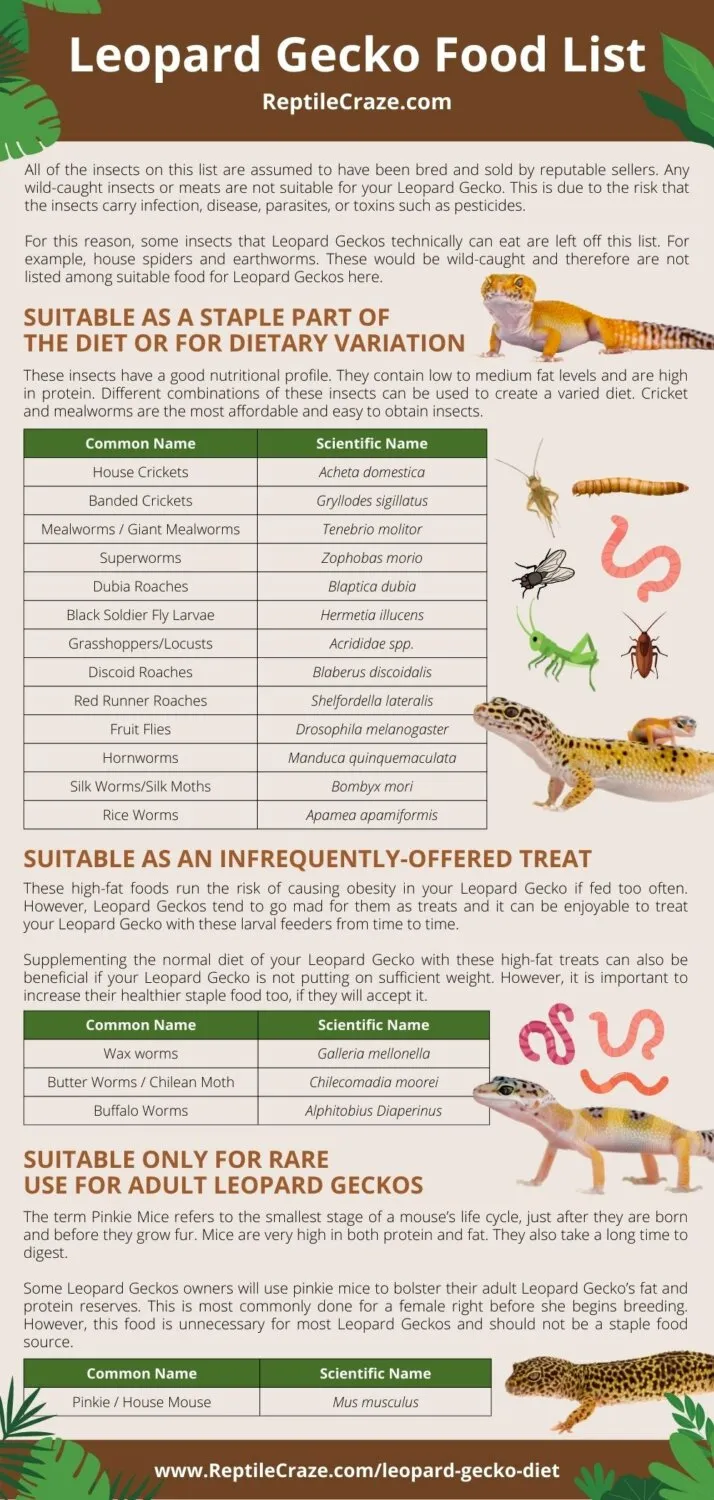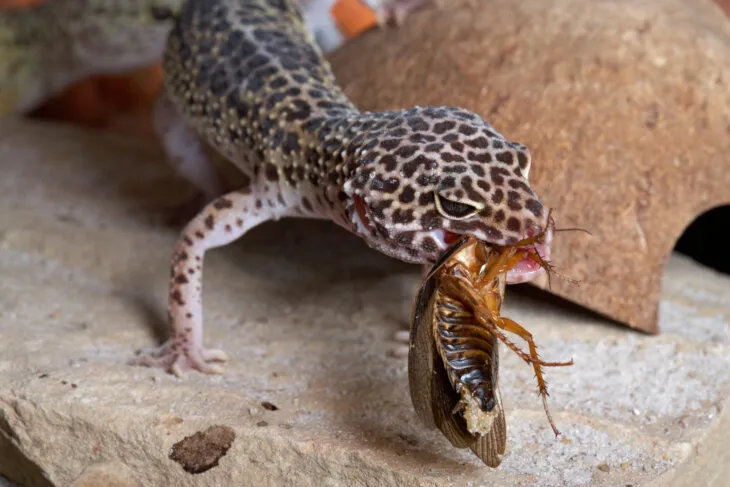
Knowing what to feed your Leopard Gecko is one of the biggest challenges of caring for your pet. One type of diet does not fit all, and your Leopard Gecko’s dietary needs will change throughout its life. So, what can Leopard Geckos eat?
Leopard Geckos are insectivores, which means that they are carnivores who almost exclusively eat insects. They should be fed a varied diet of insects such as mealworms, crickets, dubia roaches, and black soldier fly larvae. They cannot eat fruits, vegetables, or human foods.
That’s the very basic answer but there is much more to learn about what Leopard Geckos can and can’t eat and how much to give.
Table of Contents
Leopard Geckos Eat Insects
Leopard Geckos are carnivores that eat mostly insects. This makes them insectivores. In captivity, we need to feed them a varied diet of different insects.
Each type of insect has a different nutritional profile, so some are better than others for creating a diet that suits your pet’s needs. However, the insects that are available to us to feed our Leopard Geckos cannot quite meet their nutritional requirements.
As such, feeding a varied diet, alongside supplementing by gut loading and dusting insects with vitamin powders, is essential to keep our pets healthy.
Foods That Are Good For Leopard Geckos
Insects that are commonly fed to Leopard Geckos include:
- Crickets
- Grasshoppers
- Mealworms
- Superworms
- Black Soldier Fly Larvae
- Dubia Roaches
- Wax Worms
- Hornworms
- Silkworms
However, there are many weird and wonderful bugs that you can feed to your Leopard Gecko beyond this list.
The Best And Healthiest Food For Leopard Geckos
The best and healthiest
Generally speaking, this is a
The insects below are considered the best staple feeder insects for Leopard Geckos. This means that you can feed them to your Leopard Gecko daily (or for every meal).
However, you should be sure to vary what you feed. You can change between staple feeder insects, but also you can introduce treats such as hornworms and silkworms to mix things up.
Nutritional Values Of Insects You Can Feed A Leopard Gecko Daily
| Crickets | Meal Worms | Dubia Roaches | Black Soldier Fly Larvae | |
| Moisture | 73% | 66% | 65% | 64% |
| Protein | 18% | 18% | 21% | 17% |
| Fat | 6% | 10% | 9% | 11% |
| Fiber | 2% | 2% | 1% | 6% |
| Ca:P Ratio | 1:9 | 1:7 | 1:3 | 2.5:1* |
(BSF Larvae Ca:P ratio: Boykin et al., 2020)
*Research is ongoing as to whether the Ca:P ratio of BSF Larvae is absorbable, as most of the calcium is located in their indigestible exoskeletons.
What To Feed A Baby Leopard Gecko
Baby Leopard Geckos need similar foods to adult Leopard Geckos. However, the calcium to phosphorus ratio is even more important for baby and young Leopard Geckos. This is because they are more at risk of developing metabolic bone disease.
Because of this, we do not recommend that crickets be used as the primary
Buffalo worms are also a great choice for baby Leopard Geckos. They are very small and have a high protein content. However, they are also high in fat, so should not be used as a staple feeder.
Leopard Gecko Food List – Everything You Need

Why Leopard Geckos Need Supplements
Leopard Geckos need to be fed a diet that has a calcium to phosphorus ratio of 1:1-2:1. But, most insects have a calcium to phosphorus ratio that is very different to this.
Usually, the ratio is inverse, meaning that the insects offer more phosphorus than they do calcium.
If you don’t improve the Ca:P ratio of insects by gut loading, your Leopard Gecko will begin to suffer from this imbalance.
As a result, the body of your Leopard Gecko will draw the calcium that it needs for organ function from the skeleton instead of the diet. The resulting symptoms are collectively called metabolic bone disease.
A Leopard Gecko suffering from MBD will become weak and deformed. It will eventually begin fitting and die without medical intervention.
Most types of insects that you feed to Leopard Geckos should be gut-loaded. Gut loading with calcium and vitamin powder improves the calcium to phosphorus ratio of the insects and increases the vitamins and minerals inside them.
Gut loading insects means that you feed them nutritious meals in the 48 hours before delivering the insects to your Leopard Gecko. This way, when your Leopard Gecko eats the insects, he also consumes the nutritious
Dusting insects with vitamin and calcium powder before giving them to your Leopard Gecko is another way of providing supplementation. All insects are suitable for dusting.
Gut loading and dusting, if done well, can improve or correct the Ca:P ratio of insects and avoid metabolic bone disease.
Foods That You Shouldn’t Feed Leopard Geckos
Leopard Geckos have a very specific diet and don’t need
Leopard Geckos do not require meat in addition to insects. However, some large adults can occasionally be fed small pinkie mice. Adult Leopard Geckos may also eat young Leopard Geckos if they are inappropriately housed together.
There are also some insects that should be carefully avoided. This is because they are toxic to Leopard Geckos.
Some are toxic because the insect itself contains poisonous compounds, while others are toxic because of their exposure to chemicals, plants, and diseases from outdoors
Insects You Shouldn’t Feed Your Leopard Gecko:
- Fireflies
- Lightning bugs
- Wild-caught insects (especially hornworms)
- Sick or dead insects
Why Leopard Geckos Can’t Eat Fruits And Vegetables
Leopard Geckos cannot eat vegetables because they are carnivores that eat mostly insects. They lack the parts of the digestive system that omnivores and herbivores use to digest vegetables and fruits.
Therefore, Leopard Geckos are unable to take the nutrients that their bodies need from fruits and vegetables.
They are also unable to break down fruits and vegetables to allow them to pass comfortably through the digestive tract. Learn more about why Leopard Geckos can’t eat vegetables in our very detailed article here.
Fruits pose an even greater risk than vegetables than to their high acidity and sugar levels. The sugar can damage your Leopard Gecko’s teeth. Find out more in our article on why Leopard Geckos can’t eat fruit.
How Often To Feed A Leopard Gecko

Young Leopard Geckos need to eat very frequently to fuel their growth and development. However, as they age it is important to slowly introduce fasting days. See how often you should be feeding your Leopard Gecko in the table below.
You can learn more in our in-depth guide on how often to feed your Leopard Gecko (with schedule).
| Age of Leopard Gecko | Frequency of feeding |
| Baby 0-4 months | Every day |
| Juvenile 4-12 months | After 4 months of age, begin to punctuate the week with days off, until around 6 months, when they should eat every other day |
| Adult 12+ months | Every 2-3 days |
How Much To Feed A Leopard Gecko
There’s no silver bullet answer to how much to feed a Leopard Gecko. This is because young Leopard Geckos need a lot more
Also, the nutrients that your Leopard Gecko needs from the
However, the usual amount to feed a Leopard Gecko is around 5-8 insects that are suitable for your pet’s size. The size of the insects, as well as how often you feed your Leopard Gecko in a week, control how much your Leopard Gecko eats.
Here is an example of how much you might feed your Leopard Gecko by age. You can learn more and also discover other portioning techniques in our guide on how to avoid overfeeding Leopard Geckos (with weight chart).
How Much To Feed Leopard Geckos By Age
| Age of Leopard Gecko | Approximately how many insects to feed | Example meal |
| Baby 0-4 months | 5-7 small insects | 3 small black soldier fly larvae + 3 small mealworms |
| Juvenile 4-12 months | 5-7 medium insects | 4 medium dubia roaches + 2 medium black soldier fly larvae |
| Adult 12+ months | 6 to 8 large insects | 5 large crickets + 3 large mealworms |
What Size Insects To Feed A Leopard Gecko
Selecting the correct size of insect is very important for both portion control and also the safety of your Leopard Gecko. As your Leopard Gecko grows, the number of insects you feed them during each meal doesn’t change all that much.
However, the size of the insects you select for them increases in relation to your pet’s growing body size. This is why knowing how to pick correctly-sized insects is important to feeding them enough.
But, it is also important to select insects that can be safely swallowed. If the insect is too big, it could become trapped in the gastrointestinal tract and cause choking or impaction, which are very dangerous.
To select the right size of insect for your Leopard Gecko, choose one that is narrower than the width between their eyes.
This distance is about the same width as their throat and indicates whether the insect could be swallowed successfully or not.
The Right Size Crickets By Age
The following table shows the approximate sizes of cricket that are correct for Leopard Geckos by age. However, please bear in mind that every Leopard Gecko can be a little different, so it is still important to check the width between their eyes.
| Age of Leopard Gecko | Size of cricket | Age of cricket | Category |
| Baby 0 – 4 months | Pinhead to ¼ inch | Newborn to 2 weeks | Small |
| Juvenile 4 – 10 months | ⅜ to ⅝ inch | 2.5 to 3.5 weeks | Medium |
| Sub-adult/Adult 10+ months | ¾ to 1 inch | 4 to 4.5 weeks | Large |
How To Know If Your Leopard Gecko Is Eating Enough
The best way to monitor whether your Leopard Gecko is eating enough is to track their size and weight over time and compare it to the normally-accepted healthy size and weight for their age.
Weigh your Leopard Gecko by placing them in a tub on the weighing scale approximately every week to 2 weeks. Be sure to minus the weight of the tub itself!
Of course, not all Leopard Geckos will grow to the same size, so as long as their development is progressing smoothly and their body condition is healthy, don’t worry too much if your Leopard Gecko doesn’t match the chart below.
Also, males are likely to be larger than females. You can learn more about assessing the body condition of your Leopard Gecko in our article on how to tell if your Leopard Gecko is eating enough.
Approximate Healthy Weight Of Leopard Geckos By Age
| Stage | Age | Weight | Body Length |
| Hatchling | 0 months | 2 – 4 grams newborn | 3 inches |
| Baby | 1 month | 15 – 25 grams | 4 – 5 inches |
| 2 – 3 months | 20 – 30 grams | 5 – 5.5 inches | |
| Juvenile | 4-5 months | 25 – 35 grams | 5.5 – 6 inches |
| 6 – 7 months | 30 – 40 grams | 6 – 6.5 inches | |
| 8- 9 months | 35 – 45 grams | 7 – 7.5 inches | |
| Adult | 10 – 12 months | 40 – 50 grams | 7.5 – 8 inches |
| 18 – 20 months | 60 – 90 grams | 8 – 12 inches |
Why Overfeeding A Leopard Gecko Is Dangerous
Overfeeding a Leopard Gecko is dangerous in both the short and long term. If you overfeed your Leopard Gecko just a little per meal, you likely won’t observe many effects. However, over time the excessive calories will add up to cause chronic issues.
Long-term overfeeding of Leopard Geckos leads to obesity, which in turn causes a host of health problems. Most notable is hepatic lipidosis or fatty liver disease.
This happens when fat builds up in the body and overwhelms the liver, damaging its function.
If you overfeed your Leopard Gecko by a lot in one meal, you are likely to see some symptoms. These include basking excessively, as Leopard Geckos require heat on their belly to digest
Your Leopard Gecko may regurgitate some of the
Conversely, your Leopard Gecko may also suffer constipation as a result of overeating. This is a dangerous sign that an impaction could be present. Impaction causes blockage of the gastrointestinal tract and is very dangerous.
To learn more about all of these dangers and discover how to avoid them, please read our article on why overfeeding Leopard Geckos is dangerous.
What Happens If You Forget To Feed Your Leopard Gecko
If you forget to feed your baby, juvenile, gravid, sick, or underweight Leopard Gecko, this could negatively impact their health. These types of Leopard Geckos are vulnerable and need good, consistent nutritional support.
If you have forgotten to feed them, it is best to offer some

If you forget to feed your adult, healthy, or overweight Leopard Gecko, this is not a huge issue. These types of Leopard Gecko have fat stores in their tails and are not suffering from illness or malnutrition.
They will be able to wait until the next day’s dawn or dusk feeding time. Offer them
However, it is important that you don’t frequently skip meals. Leopard Geckos need a regular routine of mealtimes at either dawn or dusk. Find out more in our article on the best time to feed your Leopard Gecko.
How Long A Leopard Gecko Can Go Without Eating
Leopard Geckos can go up to 1 month without eating. However, this only applies to adults, who are at a healthy weight or are overweight. This is because Leopard Geckos can survive this long using the fat stores in their tails.
Young Leopard Geckos should not be left missing meals. Also, if a Leopard Gecko has dropped his tail, is unwell, malnourished, or recovering from illness, it is important to offer them
Below, you can see how long Leopard Geckos can go without
| Age of Leopard Gecko | Length Of Time They Can Go Without | How Often They Should Be Fed |
| Hatchling | Very Dangerous To Leave Without | Daily |
| 1 Month | Don’t Push It Beyond 1 Day | Daily |
| 2 Months | Don’t Push It Beyond 2 Days | Daily |
| 6 Months | 2 – 7 Days | Every Other Day |
| 12 Months | 14 Days – 1 Month | Every Other Day |
| 18 Months | Over 1 Month | Every Other Day |
If you are offering
These include natural reasons such as shedding or brumation. But, not eating could also indicate illness. Find out more in our diagnostic guide to why your Leopard Gecko isn’t eating.
Do Leopard Geckos Feel Hunger?
Leopard Geckos can show that they want to eat, or are not getting enough
They will also eat fast, and continue to take insects that you offer.
However, it is not known whether Leopard Geckos feel hunger in the same way that we do. This is because there is no way to find out what animals feel, or whether they have the same kind of emotions as we do.
- Eastern Rat Snake: Nature’s Pest Control and Fascinating Reptile - September 20, 2024
- Eastern Racer: The Fast and Agile Snake - September 19, 2024
- The Eastern Indigo Snake: The Majestic, Non-Venomous Hunter of the Southeast - September 18, 2024
